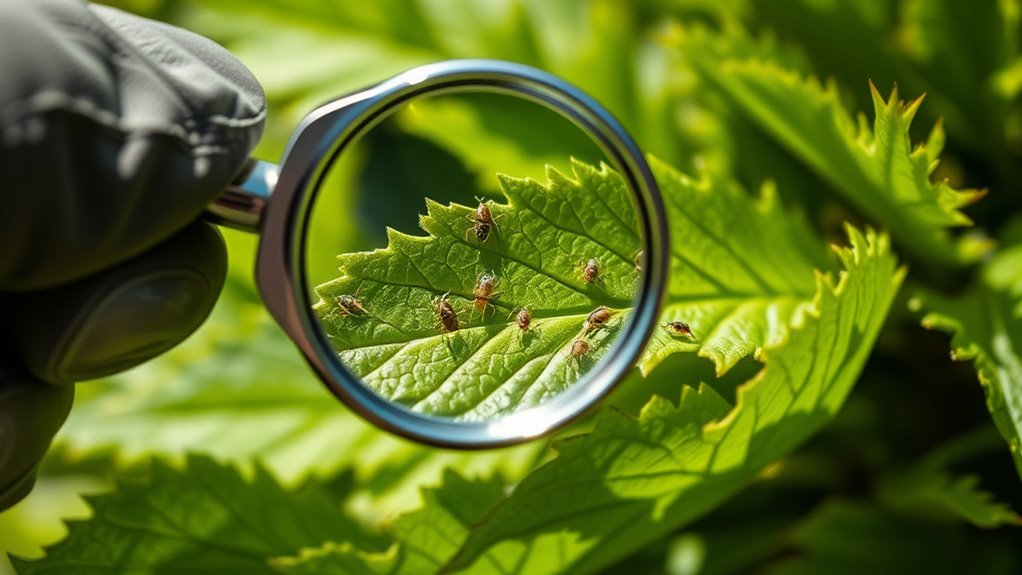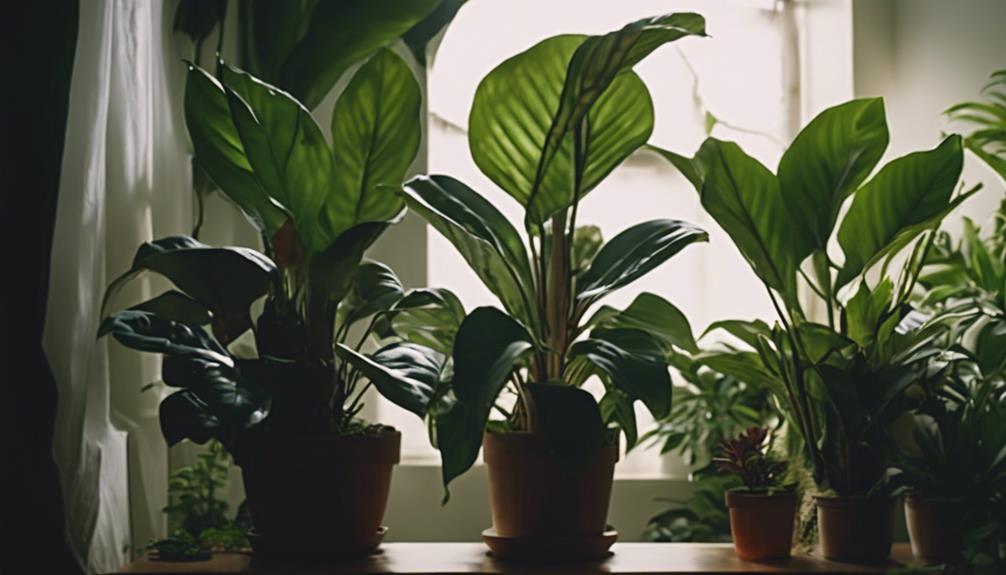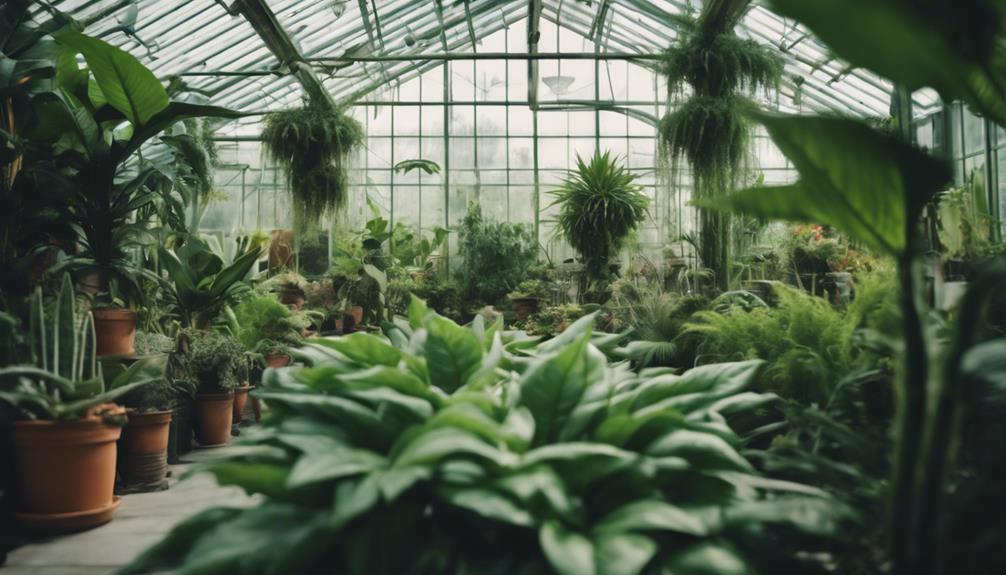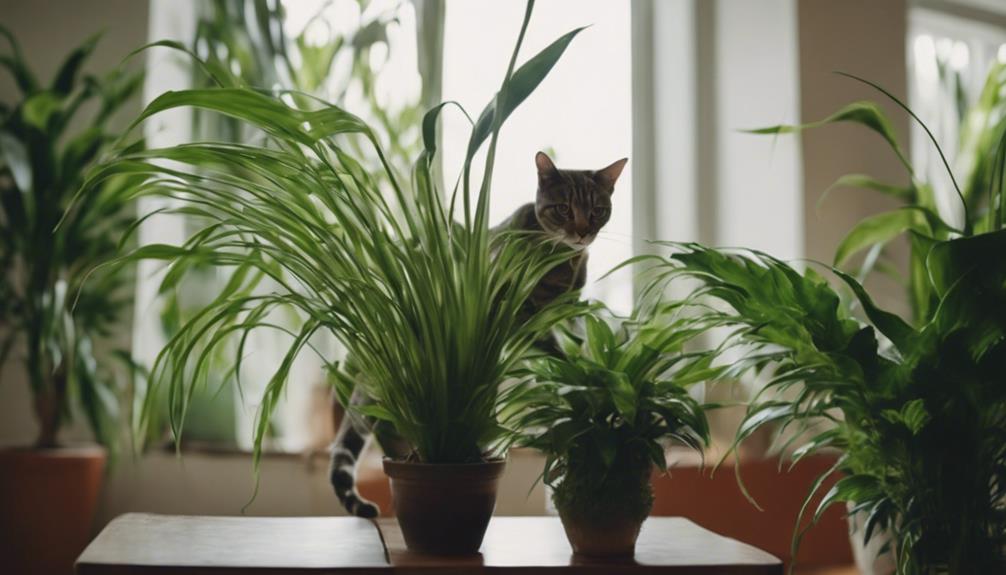Using a magnifying glass is key for diagnosing plant pests early. With it, you can closely inspect the undersides of leaves, stems, and buds to spot tiny insects like aphids, spider mites, or whiteflies that are often invisible to the naked eye. Look for signs like webbing, stippling, or clusters of pests. Developing this habit helps you catch problems early and act quickly, paving the way for healthier plants. Keep going to discover more helpful tips.
Key Takeaways
- Use a magnifying glass to closely examine leaf undersides, stems, and buds for tiny pests like aphids and spider mites.
- Look for early pest signs such as stippling, webbing, or insect clusters that may be invisible to the naked eye.
- Differentiate pest activity from other issues like nutrient deficiencies by observing specific pest behaviors and signs.
- Detect small holes, discoloration, or damage patterns indicating pest presence or feeding activity.
- Regularly inspect plants to catch pests early, enabling prompt, eco-friendly control measures.

Identifying plant pests early is essential for preventing damage and ensuring healthy growth. When you take the time to closely examine your plants with a magnifying glass, you gain a better understanding of what’s affecting them. This simple tool can reveal tiny pests that are invisible to the naked eye, such as spider mites, aphids, and whiteflies, allowing you to address issues before they escalate. The key is to look carefully at the undersides of leaves, stems, and buds, where pests often hide. Look for telltale signs like stippling, webbing, or small clusters of insects. Spotting these early means you can act quickly and prevent widespread infestations.
Once you notice pests, it’s crucial to evaluate eco-friendly solutions like encouraging beneficial insects. These natural predators, such as ladybugs or lacewing larvae, can help control pest populations without the need for harsh chemicals. Introducing or attracting these beneficial insects to your garden creates a balanced ecosystem where pests are naturally kept in check. To support their presence, plant nectar-rich flowers or install insect hotels nearby. This approach aligns with organic remedies, which focus on sustainable and chemical-free methods to protect your plants. Using organic remedies not only keeps your garden safe for beneficial insects but also preserves the health of your soil and environment.
Your magnifying glass also helps you identify early signs of pest damage, like tiny holes or discoloration, which can indicate the presence of pests or disease. Recognizing these symptoms early allows you to apply targeted organic remedies such as neem oil, insecticidal soap, or diatomaceous earth. These remedies are effective against pests and safe for beneficial insects, making them ideal choices for organic pest management. Regular inspections with your magnifying glass enable you to catch issues before they become severe, reducing the need for chemical interventions. It’s a proactive approach that keeps your plants healthy and thriving.
In addition, being vigilant helps you distinguish between pest activity and other problems like nutrient deficiencies or environmental stress. The more familiar you become with your plants’ normal appearance and growth patterns, the easier it will be to detect abnormalities early. This knowledge allows you to respond appropriately, whether by introducing beneficial insects, applying organic remedies, or adjusting watering and fertilization. Incorporating early detection techniques into your routine monitoring can greatly enhance your pest management strategy. Using a magnifying glass as part of your routine monitoring ensures you’re always aware of your garden’s health and can take swift action to keep pests at bay. Ultimately, a keen eye combined with natural, eco-friendly methods provides the best defense for your plants’ long-term vitality.
Frequently Asked Questions
Can a Magnifying Glass Detect All Types of Plant Pests?
You might wonder if a magnifying glass can detect all plant pests. While it’s a useful tool for pest identification accuracy, it has limitations. A magnifying glass helps you see small pests clearly, but it can’t identify every pest type or reveal hidden infestations. Some pests are too tiny or hide deep within plant tissues, so relying solely on a magnifying glass isn’t enough for complete detection.
What Magnification Level Is Ideal for Spotting Tiny Pests?
Did you know that tiny pests like aphids can be less than 1 millimeter long? For spotting such minuscule pests, the ideal magnification range is between 10x and 20x. This range offers enough detail to identify pests clearly without distortion. Using a magnification level within this range helps you detect even the smallest pests early, giving your plants the best chance to recover and thrive.
How Often Should I Inspect My Plants for Pests?
You should inspect your plants weekly to catch pests early, especially during seasonal pest patterns. Regular checks help you spot issues before they spread, making pest prevention strategies more effective. Pay close attention to the undersides of leaves and new growth, as pests often hide there. Consistent inspections allow you to respond quickly, keeping your plants healthy and reducing the need for chemical treatments.
Are There Any Plant Pests Invisible to the Naked Eye?
Did you know over 80% of plant pests are tiny and often invisible to the naked eye? You might miss some pests, especially beneficial insects that help control plant disease naturally. While many pests are visible, a few microscopic ones can cause damage before you notice symptoms. Regular inspections with a magnifying glass help catch these hidden threats early, protecting your plants and keeping your garden healthy.
Can a Magnifying Glass Identify Pest Eggs?
A magnifying glass can help you identify pest egg variations that are tiny and hard to see with the naked eye. While it enhances your view, it has limitations, especially with very small or transparent eggs. You might need a more powerful tool like a microscope for detailed inspection. Still, a good quality magnifying glass is a useful first step in spotting and evaluating pest eggs on your plants.
Conclusion
Using a magnifying glass is a simple yet effective way to identify plant pests early, helping you save your plants from serious damage. Did you know that over 40% of crop losses worldwide are caused by pests? By carefully inspecting your plants regularly, you can catch issues before they become overwhelming. So, keep that magnifying glass handy—your plants will thank you for the extra attention and care.










